Palyno-Stratigraphy and Kerogen Assessment of OMA Well Sediments, Offshore Dahomey Basin, Southwestern Nigeria ()
1. Introduction
The detailed study of the Dahomey Basin has increased in recent times due to the availability of more offshore data and its exploration opportunities. The potentials of the Dahomey Basin are next in exploitation to the prolific Niger delta basin which has remained a huge source of revenue for the Nigerian economy. Hence, the update and further understanding of these new data are essential for the basin stratigraphy, potentials, and other geological interpretations.
Biostratigraphy is one of the successful tools for environmental reconstruction, chronology, and age correlation in which Palynology, the study of pollens and spores, dinoflagellates, etc., is quite significant as discussed in the works of Batten (1982, 1996). Palynomorphs are plant and animal structures that are highly resistant to decay and acid treatments and as such are well preserved as microfossils suitable for environmental studies. Also, visual kerogen assessment has been a measuring tool for thermal alteration, maturation, and spore coloration deductions for source rock potential. Palynomacerals and assigned kerogen types are indicators of the source of organic matter.
Several studies on biostratigraphy in the Dahomey basin have been well reported through many centuries by various authors (Adegoke, 1969; Fayose, 1970; Billman, 1976; Omatsola & Adegoke, 1981; Okosun, 1990; Salami, 1987; Jan du Chene, 1998; Adeigbe et al., 2013; Adeigbe & Amodu, 2015). Recently, Asadu and Nkem (2020) assessed the palynological content of Well Z in the OPL 310 block in the offshore Dahomey basin. They reported the studied interval (1620 ft - 3500 ft) to be late Eocene to late Miocene in age and were mainly basal sandstone with intercalation of shale (Oshosun), which is overlain by shale (non-fissile) intercalating with Afowo sandstone. The well as a reference to the works of Brownfield and Charpentier (2006), penetrated the Oshosun and Afowo formations. There are still many nomenclature problems as the dating of younger sediments in the offshore part of the basin with the same name as the older sediments in the onshore part of the basin might not be stratigraphically appropriate. The objectives of this study include lithology classification, recovery, and identification of palynomorphs, application of the palynomorphs in understanding the deposition environment and period of the deposition as well as the kerogen assessment, typing, and coloration deduced from them for possible hydrocarbon indication.
2. Geologic Setting
The Gulf of Guinea province harbors several basins that formed as a result of the tectonic activities that separated the African and South American continental plates including the opening of the South Atlantic Ocean (Figure 1). This started during the late Jurassic era and several geologic events such as rifting and uplifts have evolved into the now basin stratigraphic systems. The tectonic events resulted in the formation and categorisation of sediments before, during, and after the rifting. The Dahomey basin spans four countries and the eastern part of the basin is located in southwestern Nigeria (Figure 2).
Many authors (Billman, 1976; Petters, 1982; Omatsola & Adegoke 1981; Elvsborg & Dalode, 1985; Okosun, 1990) have attempted to classify the stratigraphy but several issues of nomenclature still occur even as the offshore part of the basin is unraveled. According to Billman (1992), the Dahomey Basin stratigraphy can be subdivided into three chronological units; pre-lower Cretaceous folded sediments, Cretaceous sediments, and Tertiary sediments. The Cretaceous sediments are the Abeokuta group comprising the Ise, Afowo, and Araromi formations. The Tertiary sediments consist of Ewekoro, Akinbo, Oshosun, Ilaro, and Benin (coastal plain sand) formations. Brownfield and Charpentier (2006) subdivided the offshore lithostratigraphy into 18 geological units from the Jurassic to the present and they comprise mainly shale, silt, and sandstone
and he identified three unconformities within the offshore basin packages (Figure 3).
3. Methodology
3.1. Lithology
The lithological sequence of the well was established by feeling the samples and the textural characteristics such as shape, size, colour, laminations, etc. were noted. The hand lens was also used to further identify these parameters. The sample interval ranges from 2850 ft (868 m) to 6180 ft (1865 m), approximating a 1000 m interval.
3.2. Palynology
Careful palynological preparations and analyses were carried out for thirty-four (34) ditch cutting samples. The samples were well sorted for depth correlation and labeling. Standard laboratory procedures were followed to digest the samples and remove silicates and carbonates with the use of hydrofluoric acid and dilute hydrochloric acid respectively. The residue was bleached using nitric acid and washed with distilled water. The residue was then sieved through a 5 μm sieve. Labeled coverslips were mounted on the hot plate for drying after pipetting each sample residue on them. The slides were attached using Norland adhesive and were mounted on the Olympus CX41 binocular microscope for observation and identification of the palynomorphs.
3.3. Kerogen Analysis
Kerogen, the insoluble part of the organic matter is left after the minerals and silicates contained in the samples have been dissolved with acids. This serves as a qualitative and quantitative method for organic petrology (Tyson, 1993). The kerogen and colour alterations were considered for some of the samples and no oxidant was added for proper preservation of the organic matter. 20 μm was used in sieving after preparation and dried on the coverslips, covered with slides which were then mounted on the microscope for the palynomaceral identification.
4. Results and Discussions
4.1. Lithology Description
The representative samples of the OMA well were sampled at 30 ft intervals each. The total sampled depth ranges from 2850 ft to 6180 ft, with approximately 3330 ft depth interval. The stratigraphic column of the sampled interval consists of mainly shale, shale with intercalation of sandstone, sandstone, and argillaceous sandstone/silt (Figure 4). The sample sizes were fined-medium grained. The shales exhibited different shades of grey and black. The shales were highly laminated, fissile, and sheety in texture. The sandstone colour ranges from light grey to light brown, brown, and very deep brown. The shapes were sub-angular to rounded and few microfossils were observed including minerals such as mica flakes and pyrites. The depths perceived to be rich in organic matter have deeper grey/black colour of shale.
4.2. Palynomorphs Distribution
The samples are moderately preserved with few records of pollens, spores, and dinoflagellate cysts. A total of 28 diverse palynomorph species were recovered with low abundance (Figure 5 and Figure 6). The palynomorphs recorded include Monocolpites marginatus, Longapertites marginatus, Longapertites sp.,
Retimonocolpites obaensis, Retimonocolpites sp., Monoporites annulatus, Milfordia sp., Foveotriletes margaritae, Ephedripites ambiguous, Ephedripites sp., Cingulatisporites ornatus, Distaverrusporites simplex, Cyathidites minor, Cyathides sp., Laevigatosporites sp., and Verrucatosporites sp. Few dinoflagellate cysts including Cleistorphaeridium sp., Senegalinium sp., Subtilisphaera sp., Dinogymnium sp., Selenopemsphix sp., and Palaeocystodium sp.
The marine indicator, microforaminifera wall lining, was also recovered in appreciable quantities. The above assemblages are suggestive of a marine environment of deposition. The low records of pollens suggest limited plant microfossils and terrestrial influence and hence, the assemblages tend towards marine species.
![]()
Figure 5. Palynomorphs counts from OMA sediments.
![]()
Figure 6. Palynomorph and palynofacies chart of OMA well.
4.2.1. Zonation/Age Dating
The thirty-four (34) samples of the OMA well fall within two palynological zones of Williams (1975), Williams and Bujak (1977a, 1977b) and Jan du Chene et al. (1978). The first younger zone is Danea mutabilis zone while the next (older) zone is Dinogymnium euclaense zone. The boundary between the first and the second zone at 4110 meters was delineated by the top occurrence of a Dinogymnium sp. The presence of Monocolpites marginatus, Longapertites marginatus, Longapertites sp., Foveotriletes margaritae, Cingulatisporites simplex, Milfordia sp., and Cyathidites minor characterizes these two zones. The age of the first and second zones is dated Early Paleocene – Upper Maastrichtian respectively. This study established the biomarkers; Cyathidites minor (late paleocene) as Zone I and the Monocolpites marginatus (Upper Maastrichtian) as Zone II. Details of the zones recognized are discussed in Table 1.
4.2.2. Environment of Deposition
The moderate records of pollen and spores including Monocolpites marginatus, Longapertites marginatus, Longaoertites sp., Retimonocolpites obaensis, Foveotriletes margaritae, Cingulatisporites ornatus, Laevigatosporites sp., with few dinoflagellate cysts show that the selected sediments of OMA well samples were deposited within the marine environment.
The marine indicator, microforaminiferal wall linings was also recorded in an appreciable amount which supports the marine nature of the sediments (Figure 7). According to El Diasty et al. (2014), the rare/low quantity of pollens recovered suggests a distal offshore environment. Some of the dinoflagellate cysts recovered include Cleistophaeridium sp., Senegalinium sp., Subtilisphaera sp., Selenopemphix sp., and Palaeocystodium sp.
![]()
Table 1. Palynological zones recognized within OMA well.
![]()
Figure 7. Percentage relationship between the palynomorphs.
4.3. Kerogen Analysis
Palynological materials in the sampled depth contain palynodebrics and Amorphous Organic Matter (AOM). As shown in Table 2, large to medium-sized PalynoMaceral (PM) types I&II dominate the recoveries of the organic matter. Moderate records of small to medium-sized palynomaceral types III & IV were also noted. This indicates that the selected sediments of OMA well samples are dominated by the large-medium sized Amorphous cortex, structureless material (PMI), and the platy-like structured plant material (PMII) which are marine in origin (Plate 1). Moderate quantities of medium-small-sized stomata-bearing aqueous plant materials (PMIII) and black lath/needle-shaped plant material (PMIV) were also recorded within the studied section.
The dominance of 48% amorphous (I), and 36% exinite (II), with a considerable amount of the 5% vitrinite (III), and 11% inertinite (IV) kerogen types, indicate that the organic matter is mainly sapropelic and mixed humic-sapropelic types (Figure 8). The above occurrence indicates a marine environment of deposition (Tissot & Welte, 1978) with mixed kerogen types and affirms a favorable hydrocarbon generation potential for the selected samples of OMA well. Also, the high level of organic matter preservation suggests a reducing environment during deposition (Tyson, 1993).
Thermal Maturation of Pollen and Spores
Spore Coloration Index (1 - 10): The macerals exhibit yellow, orange-brown to pale-dark brown colour under the transmitted light and show a medium level of degradation. The spore colour (Table 3) ranges from light brown to brown transitioning into darker brown/black. The spore coloration scale as deduced from the palynomorphs colour is 4/5 transitioning to 7/8, equivalent to the Thermal Alteration Index (TAI) of 2 to 3+ and vitrinite reflectance (% R0) greater than 0.5. The degree of thermal maturation is inferred to be a medium degree of maturation (4/5) to a late degree (5/6) of maturation.
![]()
Figure 8. Percentage distribution of the kerogen types (1 - 4) within OMA well sediments.
 (a)
(a) 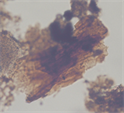 (b)
(b) 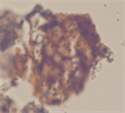 (c)
(c) 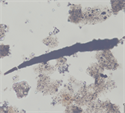 (d)
(d)
Plate 1. Large Palynomacerals (PM), kerogen types (I, II, III & IV). 20× magnification. (a) PM 1; (b) PM II; (c) PM III; (d) PM IV.
![]()
Table 2. Statistical representation of the different types of Palynomacerals (PM) abundance. S-small, M-medium, L-large.
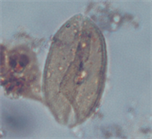 (a)
(a) 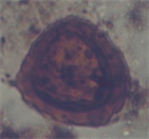 (b)
(b) 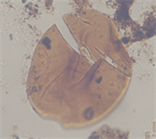 (c)
(c)
![]() (d)
(d) ![]() (e)
(e) ![]() (f)
(f)
![]() (h)
(h) ![]() (i)
(i) ![]() (g)
(g)
Plate 2. Few Pictural Representations of Palynomorphs Recovered (40× magnification). (a) Retimonocolpites obaensis; (b) Cingulatisporites ornatus; (c) Monocolpites marginatus; (d) Cyathidites minor; (e) Subtilisphaera sp.; (f) Ephedripites sp.; (g) Dinogymnium sp.; (h) Microforaminiferal wall lining; (i) Fungal spore.
5. Conclusion
The OMA well sediments appear to be deposited in a quiet, reducing environment as seen with the fissile nature of the shale, the averagely well-sorted and sub-angular to rounded grain sizes of the sandstone, and the abundance preservation of organic matter observed. Two zones were established for this study and assigned the Late Maastrichtian to late Paleocene age based on palynomorphs recovered as shown in Plate 2. The recorded low pollen and spores and a significant amount of the dinoflagellate cysts and microforaminifera lining indicated a marine setting of deposition. The palynofacies were counted and categorized based on visual assessment of the palynomaceral types, sizes, shapes, and colours, and the Type I and II kerogen types dominated the studied interval with considerable mixed type, Type II & III.
Furthermore, the thermal maturity of the organic matter was deduced based on the coloration of the palynomorphs which ranged from yellow to brown to deep brown on the Spore Coloration Index and Thermal Alteration scale which inferred middle maturation to a late degree of maturation.
The palynological and virtual kerogen assessments of the sediments of the OMA well have further proven that the offshore Dahomey Basin is viable for hydrocarbon. This study has also established the age and depositional environment of the studied lithology intervals for further basin stratigraphic analyses.
Acknowledgements
The authors appreciate the Pan African University, Life and Earth Sciences (Including Health and Agriculture), Ibadan, Nigeria. We also thank Crystal Age, Lagos for access to their lab.